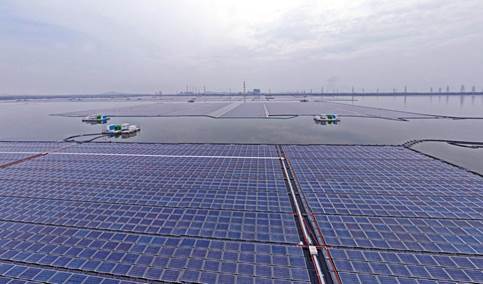Context
-
India’s largest floating solar plant is now fully operational at Ramagundam in Telangana’s Peddapalli district.
About India’s largest floating solar plant
- The 100-megawatt (MW) floating solar power photovoltaic project was commissioned by the National Thermal Power Corporation, the country’s foremost public-sector power generator.

Photo Credit: PIB - Solar plants or solar farms can be either ground-mounted or set up on the surface of waterbodies.
- Though these floating farms are a bit more expensive than the traditional ones mounted on land surfaces, there are advantages as well.
- At a time when large tracts of land are unavailable, floating farms do not require land to be acquired for the installation of photovoltaic panels. They are more efficient as the presence of water underneath helps them keep cool.
- They also reduce water evaporation, thereby saving more water for hydropower generation.
How are these panels kept floating?
- At Ramagundam, the solar modules are placed across 500 acres on floaters manufactured with high-density polyethene material that keeps floating irrespective of water-level fluctuations.
- The entire spread is divided into 40 blocks, each having a capacity of 2.5 MW.
- Each of these blocks consists of a floating platform and an array of 11,200 solar modules.
- The floating platform consists of an inverter, transformer, and a high-tension circuit breaker.
How is the project unique?
- This project is unique because all the electrical equipment from the inverter, transformer, high-tension panel to supervisory control and data acquisition are also set up on floating ferro-cement platforms.
- According to the NTPC, the entire floating system is anchored through special high-modulus polyethylene ropes to the dead weights (concrete blocks) placed in the balancing reservoir bed. The generated power is evacuated up to the existing switch yard through 33KV underground cables.
How does it help the environment?
- The solar panels floating on the water surface will reduce the evaporation rate and thereby help water conservation.
- Also, with a minimum land requirement, mostly for associated evacuation arrangements, available land can be put to better use unlike in the case of ground-mounted solar farms, which require large land surface areas.
- The waterbody underneath the solar modules helps in maintaining their ambient temperature, thereby improving their efficiency and generation.
- Similarly, coal consumption of 1,65,000 tons can be avoided per year; carbon dioxide emissions of 2,10,000 tons per year can be avoided.
Visit Abhiyan PEDIA (One of the Most Followed / Recommended) for UPSC Revisions: Click Here
IAS Abhiyan is now on Telegram: Click on the Below link to Join our Channels to stay Updated
IAS Abhiyan Official: Click Here to Join
For UPSC Mains Value Edition (Facts, Quotes, Best Practices, Case Studies): Click Here to Join
